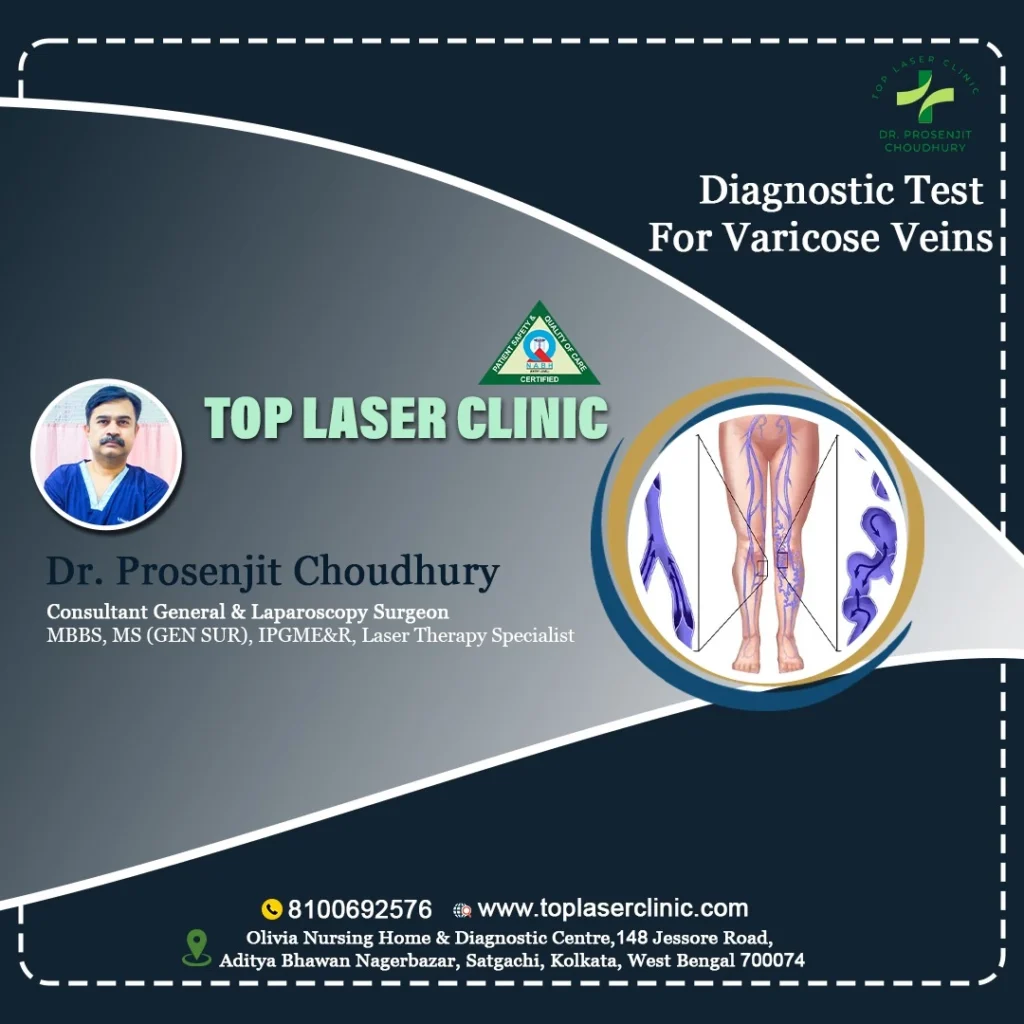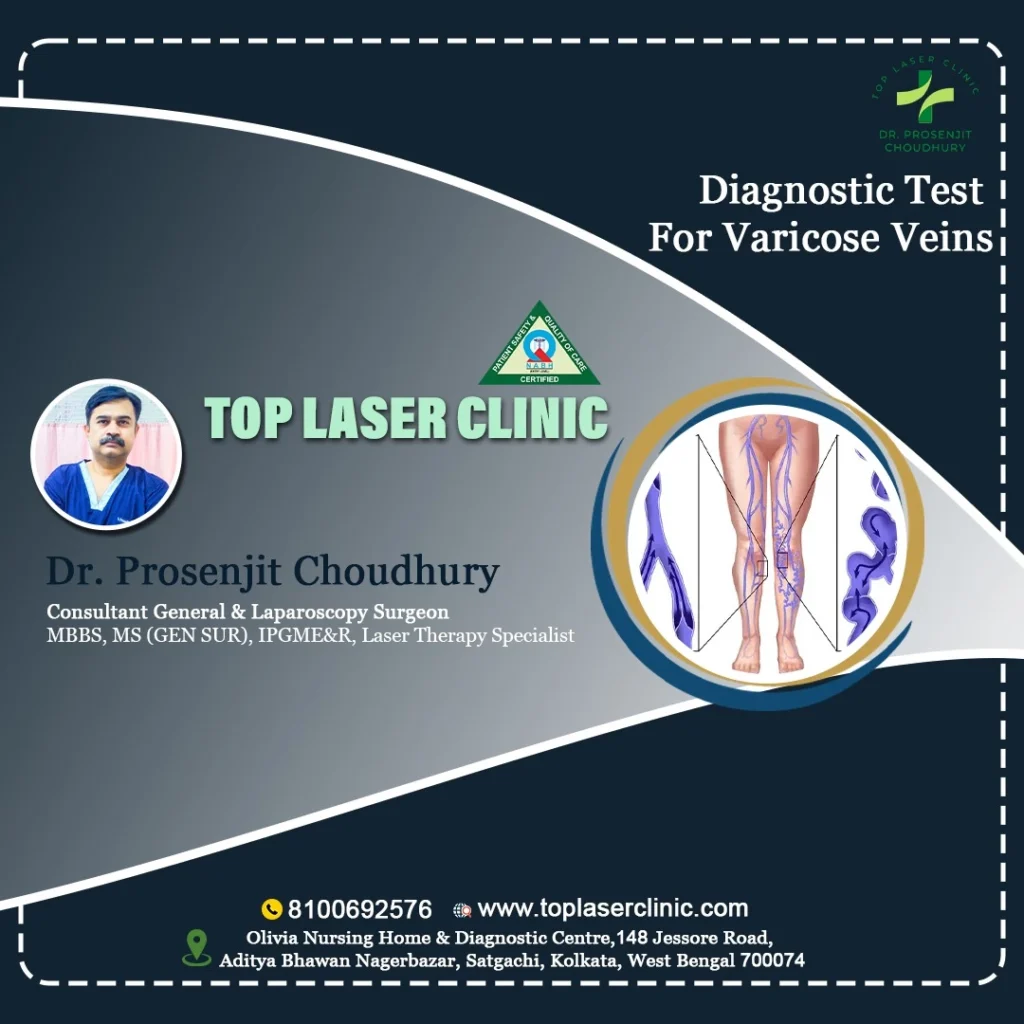
Table of Contents
Diagnostic test for varicose veins
When diagnosing varicose veins, healthcare professionals typically start with a physical examination and medical history review for Diagnostic test for varicose veins. The doctor will assess the appearance and location of the veins, as well as inquire about any symptoms you may be experiencing.
In addition to the physical examination, there are several diagnostic tests that can provide more detailed information about the condition of the veins and help guide treatment decisions. These tests may include:
1. Doppler Ultrasound :
Doppler ultrasound is a commonly used imaging test for evaluating varicose veins. It uses sound waves to visualize the blood flow in the veins and assess the functioning of the valves. This test can help identify areas of reflux (backward flow) and determine the extent and severity of the varicose veins.
2. Duplex Ultrasound :
Duplex ultrasound combines traditional ultrasound imaging with Doppler ultrasound. It provides detailed images of the veins and their surrounding structures while simultaneously evaluating the blood flow. Duplex ultrasound can help identify any blood clots or other abnormalities in the veins.
3. Venogram :
Venogram involves injecting a contrast dye into the veins and taking X-ray images to visualize the blood flow. This test is usually used in more complex cases or when other imaging tests have not provided sufficient information.
4. Magnetic Resonance Venography (MRV):
MRV is a non-invasive imaging technique that uses magnetic resonance imaging (MRI) technology to visualize the veins and blood flow. It can provide detailed images of the veins without the need for contrast dye.
These diagnostic tests help determine the location, extent, and severity of varicose veins and provide valuable information to guide treatment decisions.
Radiofrequency ablation varicose veins
Radiofrequency ablation (RFA) is a minimally invasive procedure used to treat varicose veins. It is a form of endovenous thermal ablation, meaning it involves using heat to close off and seal the affected veins.
During the RFA procedure for varicose veins, the healthcare professional inserts a thin catheter into the diseased vein under ultrasound guidance. The catheter delivers radiofrequency energy to the vein wall, causing it to heat up and contract. The heat generated by the radiofrequency energy destroys the vein, leading to its closure. The procedure is usually performed under local anesthesia or mild sedation.
Radiofrequency ablation offers several advantages as a treatment option for varicose veins
1. Minimally Invasive :
RFA is a minimally invasive procedure that can be performed in an outpatient setting. It typically requires only a small incision or needle puncture, resulting in less scarring and a faster recovery compared to traditional vein-stripping surgery.
2. High Success Rate:
RFA has shown high success rates in closing off the treated veins, relieving symptoms, and improving the appearance of varicose veins.
3. Reduced Pain and Bruising :
RFA causes less pain and bruising compared to traditional surgery. Many patients report minimal discomfort and a quicker return to normal activities.
4. Quick Recovery:
Recovery after RFA is generally faster than after surgical procedures. Most individuals can resume regular activities within a few days to a week after the procedure.
5. Effective and Long-lasting Results:
RFA provides long-term relief from varicose veins by addressing the underlying cause. The treated veins are closed off, and blood flow is rerouted to healthier veins, improving circulation and reducing symptoms.
It’s important to note that RFA is not suitable for all cases of varicose veins. A thorough evaluation and consultation with a healthcare professional, such as a vascular specialist, are necessary to determine the most appropriate treatment approach based on individual circumstances and vein condition.

Is Ice pack good for varicose veins?
Applying an ice pack or cold compress to varicose veins can provide temporary relief for symptoms such as pain, swelling, and discomfort. The cold temperature helps constrict the blood vessels and can temporarily reduce inflammation and numb the area.
Here are some tips for using an ice pack on varicose veins:
1. Prepare the ice pack:
Fill a sealable plastic bag with crushed ice or use a gel ice pack. Alternatively, you can wrap ice cubes in a thin cloth or towel.
2. Protect your skin:
To prevent direct contact between the ice pack and your skin, wrap it in a thin cloth or towel. This helps avoid potential damage to the skin from extreme cold.
3. Apply the ice pack:
Gently apply the wrapped ice pack to the affected area of varicose veins. Hold it in place for about 15-20 minutes.
4. Take breaks:
It’s important not to apply ice directly to the skin for an extended period. Take breaks between applications to allow the skin to warm up.
5. Elevate your legs:
While using the ice pack, consider elevating your legs to help reduce swelling and improve circulation. Prop up your legs with a pillow or cushion.
6. Follow a safe routine:
Avoid leaving the ice pack on for too long or applying excessive pressure to the varicose veins. Be mindful of your comfort level and discontinue use if you experience any adverse effects.
Keep in mind that using an ice pack provides temporary relief and does not address the underlying causes of varicose veins.
What is varicose vein pillow?
A varicose veins pillow, also known as an elevating leg rest pillow or wedge pillow, is a specialized pillow designed to elevate the legs while lying down. These pillows are often recommended to individuals with varicose veins or other conditions that benefit from leg elevation, such as swelling, edema, or venous insufficiency.
Varicose veins pillows typically have a wedge shape or a contoured design that allows for comfortable elevation of the legs and proper support. They are usually made of foam or memory foam to provide cushioning and maintain their shape.
The primary purpose of a varicose veins pillow is to promote proper blood circulation and reduce venous congestion in the legs. By elevating the legs above the level of the heart, these pillows help facilitate the return of blood flow from the lower extremities, reducing the pooling of blood in the veins and alleviating symptoms associated with varicose veins.
When using a varicose veins pillow, it’s important to position it correctly. Place the pillow under the lower legs or calves, ensuring that the heels are fully supported. This allows for a gradual elevation of the legs while keeping the knees slightly bent for added comfort.
While varicose veins pillows can provide temporary relief and improve circulation, they do not address the underlying causes of varicose veins. They are typically used as part of a comprehensive treatment approach that may include lifestyle modifications, compression therapy, and medical interventions, depending on the severity and symptoms of the varicose veins.